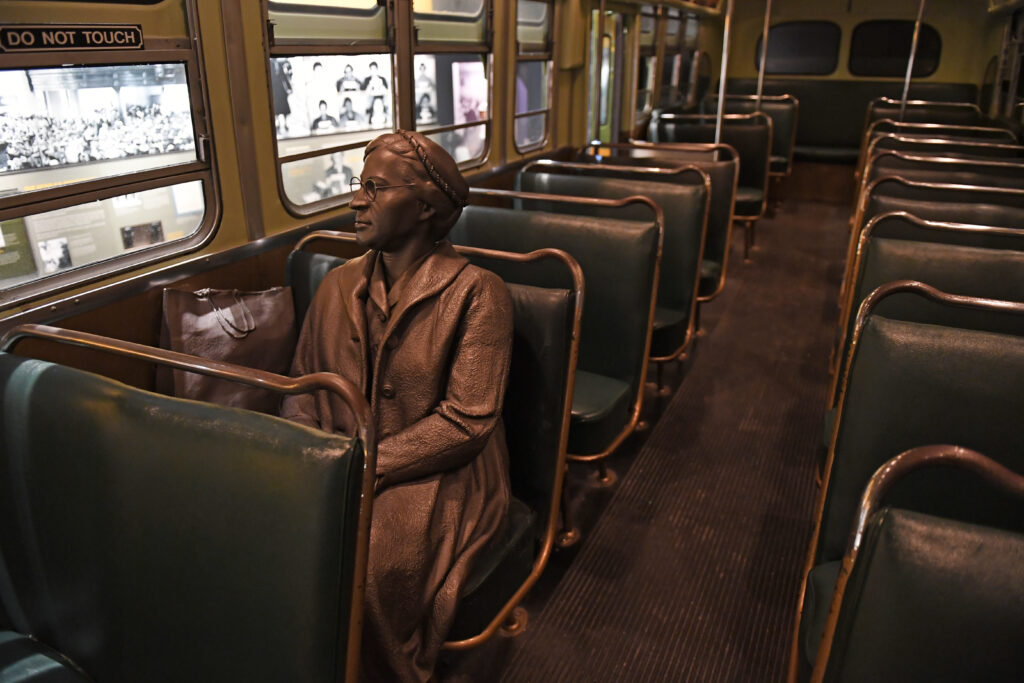When you hear the name “Rosa Parks,” you instantly picture that iconic image: a dignified woman refusing to leave her seat on a city bus. Still, there’s far more to any human life than just one moment in time. In honor of Black History Month, here are some fascinating facts about Rosa Parks that you may not have heard before, courtesy of COBBLESTONE and CRICKET Magazines!
Rosa Parks and her husband were active in the Civil Rights movement long before the Montgomery bus boycott.
Born Rosa Louise McCauley, she married Raymond Parks at age 19. He was already active in fighting for civil rights and racial justice, and soon Rosa became involved, too. She served as the secretary of the Montgomery chapter of the NAACP for twelve years, working on many important cases. She notably took part in organizing “The Committee for Equal Justice for Mrs. Recy Taylor,” described by the Chicago Defender newspaper as the “strongest campaign for equal justice to be seen in a decade.” Rosa and Raymond were also champions of voting rights, both belonging to the League of Women Voters.
Rosa Parks wasn’t the first person in Montgomery to refuse to leave her seat on a segregated bus.
Nine months before Parks made headlines in December 1955, Claudette Colvin took her own stand— or rather, refused to stand. At only 15 years old, Colvin was forcibly removed from a Montgomery city bus and arrested for “violating segregation law, disorderly conduct and assaulting a police officer.” Her juvenile record wasn’t fully expunged until 2021. Why didn’t Claudette Colvin become as famous as Rosa Parks? Local civil rights leaders declined to pursue her case. Colvin herself believes this is partly because she seemed like a “juvenile delinquent” and not an ideal figure for the movement to rally around—particularly when she became pregnant outside marriage.
Rosa Parks wasn’t actually sitting at the front of the bus on that historic day.
Most of us first learned about Rosa Parks when we were small children. Naturally, many teachers and children’s authors tend to simplify their storytelling to get important themes across. If you ask many people where Rosa Parks was sitting when the driver asked her to move, they’ll often say, “She was in the front of the bus” or “She was in a ‘whites-only’ section.”
In truth, however, Parks wasn’t sitting in “whites-only” seating or at the front of the bus. She was sitting in the fifth row, the frontmost allowed for passengers of color. The policy on Montgomery city buses was that, when the “whites only” section filled up, Black passengers had to move further back and make room for white people. Bus drivers could move or even remove the signs designating which seats were for which passengers.
This wasn’t her first unjust encounter with this particular bus driver.
The bus driver who demanded that Rosa leave her seat was named James F. Blake. Although she didn’t recognize him when she first boarded the bus, she soon realized that she’d ridden with him before—and he’d treated her unfairly then, too. Over ten years before, in 1943, Parks had boarded a bus only for Blake to insist she get off and re-board from the back. There seemed little point to doing so when she was already on the bus in the first place. Still, she obeyed. After Parks got off to re-board, the bus sped away and left her standing in the rain. It’s no wonder that she refused to move for Blake a second time!
Rosa Parks lost her job due to the bus boycott.
At the time, Parks worked as a seamstress at a local department store. About a month into the Montgomery Bus Boycott, she was fired. Her husband Raymond, who had worked as a barber on an Air Force base, lost his job, too, simply because of the case surrounding his wife. Unable to get work in Alabama due to the publicity surrounding the bus boycott, the Parks family moved to Detroit. The couple struggled financially for many years, despite—or indeed because of—Rosa’s fame. Eventually, Parks found a stable job in which she excelled: working for US Congressman John Conyers. In fact, she worked with him for 23 years. Conyers later said, “Rosa Parks was so famous that people would come by my office to meet her, not me.”

When Rosa Parks became the victim of a crime, she found help in a very unexpected place.
Despite her treasured place in American history, Rosa Parks continued to face adversity long after the Montgomery bus boycott. In 1994, a man named Joseph Skipper robbed and attacked then-81-year-old Parks in her Detroit home. Of the incident, which the press sometimes used to villainize the local Black youth, Parks simply said, “I hope to someday see an end to the conditions in our country that would make people want to hurt others.”
Still, she was understandably shaken by the attack and soon decided to move from her longtime home. Fortunately, she received some community support as she made this transition. Not only did local federal judge Damon Keith help her find a safe and secure new apartment, a well-known figure in Detroit helped pay her rent: billionaire Mike Ilich, best known as the founder of Little Caesar’s pizza and the former owner of the Detroit Tigers.
Rosa Parks published two books based on her own life experience.
In 1992, Parks released an autobiography co-written with Jim Haskins called My Story. Perhaps unusually for a famous historical figure, this book was intended for children. With so many schoolchildren learning about Parks from an early age, it makes sense that she wanted to share her story in her own words. She later co-authored a memoir with Gregory J. Reedcalled Quiet Strength: The Faith, the Hope, and the Heart of a Woman Who Changed a Nation, this time intended for an adult audience. If you’d like to learn more about Rosa Parks and her own thoughts and feelings, these are great places to start!
Rosa Parks won several of the nation’s highest honors and was often the first woman or person of color to do so.
Parks was awarded the two most prestigious civilian honors in the USA, the Presidential Medal of Freedom (1996) and the Congressional Gold Medal (1998). These medals are awarded by the US President and Congress respectively. In the US Capitol, you can find a full-length statue of Rosa Parks in the National Statuary Hall. This statue holds a few unique distinctions among its peers in Statuary Hall: it is the only statue not representing any specific state, and it was the first statue to honor an African-American person. When Rosa Parks died in 2005, her body lay in honor in the Capitol rotunda. She was the first woman and second Black person to be honored this way—and only the second private citizen. A 1950s era bus took part in the motorcade.
There’s more than one “Rosa Parks Day” in the USA!
What day do we honor Rosa Parks and her legacy? Well, it’s a bit of a trick question. It depends on where you live. If you live in Missouri or Massachusetts, Rosa Parks Day falls on her birthday, February 4th. This date is also celebrated as Transit Equity Day around the country. You’ll often find a special seat reserved in her honor on trains and buses on this day! If you live in California or Michigan, Rosa Parks Day falls on the Monday after her birthday. Several other states, including Alabama itself, celebrate Rosa Parks Day on the anniversary of the day she refused to move from her bus seat: December 1. Rosa Parks Day may one day become a federal holiday. In the meantime, however, we’re celebrating in our own way by sharing her amazing life story!
Celebrate Black History Month with these past blog posts!
7 Amazing People You Should Know for Black History Month
13 Things You Didn’t Know About Frederick Douglass
12 Facts You Didn’t Know About Ida B. Wells
12 Facts You Didn’t Know About Harriet Tubman
10 Things That You May Not Know About Martin Luther King, Jr.



